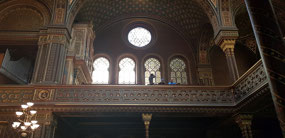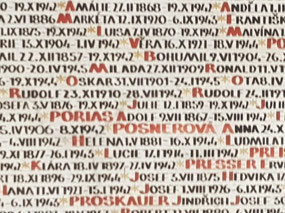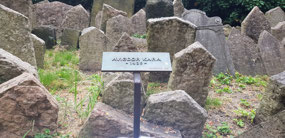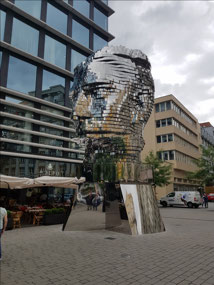We
packed up the car and took it to a local supermarket carpark while Katherine
and Jess went into the owner’s restaurant to return the keys. That sounds odd
but we found the parking at the local Kaufmann was not expensive and a good
option for the last half day.
We
then headed for the Jewish area. John was a bit confused as we had mentioned
museum without saying that the museum is spread over a few synagogues, each
with a different focus. Jess and Katherine had highly recommended it and
suggested we opt for tour 2. That also looked best for us.
We
first went to the Spanish Synagogue that looked at the history of the Jews in
Prague over time. It was often a story of persecution but peaked of course in
WW2. The next stop was a rather random Gallery which left us more bemused than
informed.
The
main part of the visit is the Pink Synagogue. The walls are covered with the
names of people killed in WW2. It reminded us of the Menin Gate, except the
ages were a wider range. Outside was an exhibition of tracing the ‘Journeys of
No Return’, of people sent from Prague to the concentration camps.
We
then walked through the crowded historic cemetery with the grave stones packed
tightly together and often listing 12 names being the people buried beneath in
layers.
There
were 2 more buildings looking at Jewish customs but, after a quick look, we
decided we would not visit. Instead I went back to the Pink Synagogue to see if
I could reenter to see the children’s art that I had somehow missed when we
first went through.
I
had heard about Ruth Halova in Cesky Krumlov at the synagogue. There were 111
people of Jewish faith before 1938 in Cesky Krumlov and only two Jews returned
after World War 2 in 1945, Mrs. Ruth Hálová and one man. Ruth Halova is the
last remaining Jewish person living in Ceský Krumlov. She was one of the
children saved by the Kindertransport.
Our guide yesterday had spoken with huge admiration about
Nicholas Winton who organised the rescue of 669 children from Czechoslovakia on
the eve of WW2. He had kept quiet about his actions, even from his wife, as he
felt he was nothing special.
Winton found homes for the children and
arranged for their safe passage to Britain.The world found out
about his work with the Kindertransport over 50 years later. In 2003, Winton
was knighted for "services to humanity” and in October 2014, he
was awarded the highest honour of the Czech Republic, the Order of
the White Lion (1st class), by Czech President Miloš Zeman. At the age of
101 he was alert and with it, and still humble about his actions.
Today
we heard about Friedl Dicker-Brandeis. When she was sent to the Terezin concentration camp, her
50kg of luggage (all she was allowed) was mainly art supplies which she used to
give art lessons to the children. Before being deported to Auschwitz, Friedl
Dicker-Brandeis filled two suitcases with about 4,500 children's drawings and
put them in a secret place; immediately after the war, they were recovered and
handed over to the Jewish Museum in Prague. These drawings are a poignant reminder
of the tragic fate of Bohemian and Moravian Jews during the Second World War.
Only a few of the Terezín children survived. The vast majority were deported to
Auschwitz where they faced certain death. It was this artwork that I went back
to see. The ticket collector kindly allowed me to reenter and let me out again
later.
We then walked about 1km through town to a new to
us area to see an interesting bust of Kafka. It was highlighted for us as it
was the focus of a virtual cache. The listing said ‘The individual
moving layers of Kafka's head are designed to illustrate the multilayer nature
of the human personality. The bust is composed of 42 layers, each of which can
move independently of each other. The whole bust is 10.6 meters tall and its
weight is 39 tons. This unique statue has 21 motor modules, and about 1 km of
cables. Some people consider it to be a jewel of art, a link between art and
modern technology. According to some others, it is overwhelmingly repulsive. We
thought it was odd but not unpleasant. We had a light lunch then headed back to
the car.
We then took Jess to the airport before heading to Karlovy Vary.
All went well until we were getting close to the apartment we had booked. It
all looked strange as we were first in countryside with no sign of a town, then
in a rather rundown area before driving by farmland into a suburban area. We
would have thought we were wrong but there was the lockbox we expected and the
code worked. However, we found ourselves in a single bedroom. A phone call was
not helpful as we don’t speak Czech, German or Slovak but a written message
gave us the reply that we were also booked for a second room. All worked out in
the end. Our 2-bedroom apartment was in fact 2 separate bedrooms with a
microwave and fridge on the landing and a private bathroom. The only downside
was the bathroom was 1 floor down but the rooms were great so we decided it was
all good.
A couple of drives later and we had supplies for breakfast, a
parking spot sorted for tomorrow and a cheap evening meal at a place found by
googling for ‘Restaurant near you’.

 Karlovy Vary, Karlovarský kraj, Czech Republic
Karlovy Vary, Karlovarský kraj, Czech Republic










2025-05-22